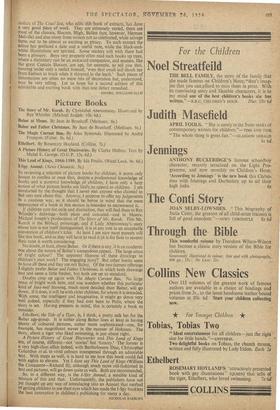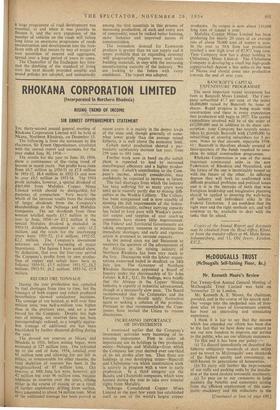Picture Books
Babar, at Home. By Jean de Brunhoff. (Methuen. 6s.)
Babar and Father Christmas. By Jean de Brunhoff. (Methuen. 6s.) Ethelbert. By Rosemary Hoyland. (Collins. 7s.)
in a cautious way, so it should be borne in mind that the mere appearance of a book in this section is intended to recommend it. If children care for, style and distinction, they will find them in Rex Whistler's drdwings—both plain and coloured—and in Messrs. Michael Joseph's productions of The Story of Mr. Korah. This Mr. Korah is the Biblical personage, and if Lady Aberconway's story about him is not itself distinguished, it is at any rate in an acceptable convention of children's tales. At least I am sure most parents will like this book, and as they will have to read it (it is for fives to sevens) their taste is worth considering.
No doubt, at least, about Babar. Or if there is any, it is an academic
one about the nature of Babar's tremendous appeal. The large areas of bright colour? The apparent likeness of these drawings to children's own work? The engaging story? But other books seem to have all these and they are not Babar. Of the two current offerings I slightly prefer Babar and Father Christmas, in which both drawings and text seem a little fresher, but both are up to standard.
Doubts crop up again with The Magic Currant Bun. No large areas of bright wash here, and one wonders whether this particular kind of faux-nail drawing, much more detailed than Babar, will go down. If it does, it will be with older children, for whom it is intended. With some, the intelligent and imaginative, it might go down very well indeed, especially if they had ever been to Paris, where the story is set. Having presents in mind, this is certainly a book to consider. a large programme of road development was essential, as and when it was possible to finance it, and the very expansion of the number of vehicles on the roads will before long force an enormous programme of roads reconstruction and development into the fore- front with all that means by way of usages of vast quantities of cement and aggregates, spread over a longperiod of years to come. The Chancellor of the Exchequer has fore- cast the doubling of the standard. of living over the next decade provided sensible and sound policies are adopted, and undoubtedly
among the first essentials in this process of increasing production, of each and every sort of commodity, must be ranked better housing, more factories and improved means of communication.
The immediate demand for Eastwoods products is greater than we can supply and it seems probable that an expanding economy will progressively, require more and more building materials, in step with the increasing manufacturing capacity of the industry. We are looking to the future with every confidence. The report was adopted.











































 Previous page
Previous page